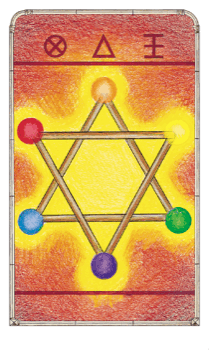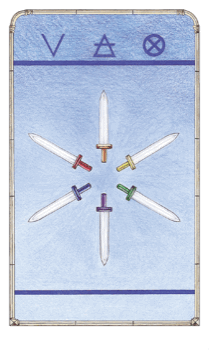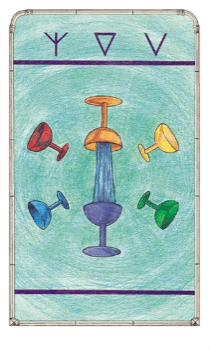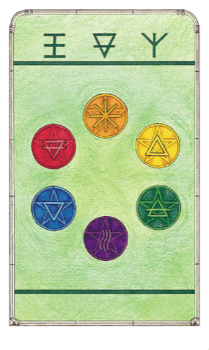 Send
comments about this page
Send
comments about this page Last update: 6 Sep 2022
The Impulse of the Pentad is unbalanced - so it may aim for the Heavens and neglect the Abyss, or aim for the Abyss and neglect the Heavens; but the Hexad balances it: as Above so Below. Thus the Hexad brings the New Dimension into the Realm of the Known and into the Cosmos.
There are Three Active Hexads in the path from the Monad to the Decad: The First Hexad carries the Monad to its Completion in the Triad (1 + 2 + 3 = 6); the Second Hexad carries the Tetrad to its Completion in the Passive Hexad (4 + 5 + 6 = 15, 1 + 5 = 6); the Third Hexad carries the Heptad, which is the Hidden Monad, to its Completion in the Ennead (7 + 8 + 9 = 24, 2 + 4 = 6). This is so because the Decad itself is no more than the Final Unity (10 = 1).
In the First Transformation, Unity (1) advances through Separation (2) and Completion (3) to Consolidation (4). Catalyzed by the Pentad, the Active Hexad creates the Second Transformation from the First, for the Second advances from Hidden Unity (7) through Reciprocation (8) and Completion (9) to Consolidation (10).
The Hexad is the Principal of Harmony, for it incorporates both the Dyad and the Triad, and these two together generate every Perfect Consonance (the Octave, Fifth and Fourth). And so the Pythagoreans say that it conquers Difference, and brings together whatever is Contrary or at Variance.
The Pentad brought the Vegetative Life Principle into the World; now the Hexad imparts the Principle of Animate Life. The Pythagoreans call the Hexad the Maker of the Soul and Condition of Life, and they say it gives the Body its Composition and Articulation, for the Soul is Harmonic in that it Reconciles and Orders the Opposites. For this reason, and because the Hexad is Equal to its Own Parts, they call it Wholeness of Limbs, Health, and the Panacea (All-Healer).
The Triad is the First Perfection, because it has Beginning, Middle and End, but the Hexad is the Second Perfection because it is Equal to its Parts (1 + 2 + 3 = 6 = 1 X 2 X 3). The Hexad includes the Triad's Perfection (but not vice versa), for the Hexad comprises the Monad, Dyad and Triad, which correspond to the Beginning, End and Middle, respectively.
The Pythagoreans call the Hexad "Reconciliation" and "Androgynous" because it blends the Female and the Male (6 = 2 X 3), whereas the Pentad merely joins them (5 = 2 + 3). Thus the Hexad is represented by the Hexagram, which comprises a Male (upward) Triangle of Fire, and the Female (downward) Triangle of Water, and so it is the Perfect Balance, the Fiery Water and the Watery Fire. So also they say the Hexad represents Marriage, and beyond that Offspring, because the Hexad is Equal to its own Parts. In this way, the Hexad reconciles all Polarities, and the Pythagoreans say that the Hexad reflects the Perfection of the Universe.
In summary, the Hexad heals the Crisis of the Pentad, and establishes a New Order characterized by Harmony, Balance and Reconciliation.




Image: Six simple staffs arranged as a hexagram on a warm, glowing background. A colored light glows at each corner where the wands meet: clockwise from the top, the colors are orange, yellow, green, violet, blue, red.
Commentary: The hexagram represents the unification of the elements, since it is a superposition of the symbols of the four mundane elements. The glowing corners represent the six directions. Violet is the color of knowledge, humility and spirituality (Biedermann s.v. violet; Cooper s.v. Colours). The upper and lower points correspond to the two alchemical seeds, the Sun and Moon, or gold and silver, which are the first two of four Celestial Elements. The other four points are the mundane elements in their alchemical square of opposition.
Image: Six swords arranged as a star (hilts to center) on a sky-blue background. Clockwise from the top, the hilts are colored orange, yellow, green, violet, blue, red.
Commentary: The points, which represent the six directions, are directed outward for serenity, which is also represented by the clear sky.
Image: Six cups in a hexagonal arrangement on a blue-green background. Clockwise from the top, the colors of the cups are orange, yellow, green, violet, blue, red. The topmost (orange) cup pours water into the bottom (violet), which have their mouths toward the center; the other (diagonal) cups have their mouths to the outside.
Commentary: The vertical cups represent Heavens fertilizing the Abyss. The alternating sizes and orientations of the cups represent balance.
Image: Six pentacles in a hexagonal arrangement on a yellow-green background. The pentacles are engraved with elemental symbols; clockwise from the top: Sun, gold or celestial spirit (eight-rayed star); fire; air; Moon, silver or abyssal spirit (three vertical wavy lines); water; earth. Their colors are orange, yellow, green, violet, blue, red, respectively.
Commentary: The verdant yellow-green background represents general material well-being. The vertical wavy lines represent water in its spiritual aspect, the spirit of intuition (Lungmann, 99, 167, 172-3, 215). It is also a symbol associated with Ea (Enki), Lord of the Abyss, as Water-Bearer. The hexagonal arrangement is the Pythagorean Hexagram, which shows the interrelations of the elements; it is obtained by adding the abyssal spirit to the bottom of the Pythagorean Pentagram. The hot power of the Sun flows down into the fire element and from there into air. The dry power of the Sun flows into the earth element and from there into fire. The cold power of the Moon rises up into the water element, and then into earth. The wet power of the Moon rises up into air, and from there into water. Going clockwise from the abyssal spirit (Moon), the Greek characters '/U/G/I/EI/A (hugieia, well-being) represent the six elements, with the rushing, rough-breathing mark (') representing the abyssal spirit.
 Send
comments about this page
Send
comments about this page
Last update:
6 Sep 2022